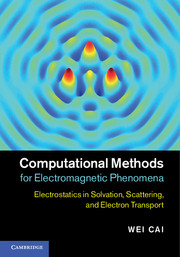 Computational Methods for Electromagnetic Phenomena
Computational Methods for Electromagnetic Phenomena Book contents
- Frontmatter
- Contents
- Foreword
- Preface
- Part I Electrostatics in solvation
- Part II Electromagnetic scattering
- Part III Electron transport
- 12 Quantum electron transport in semiconductors
- 13 Non-equilibrium Green's function (NEGF) methods for transport
- 14 Numerical methods for Wigner quantum transport
- 15 Hydrodynamic electron transport and finite difference methods
- 16 Transport models in plasma media and numerical methods
- References
- Index
12 - Quantum electron transport in semiconductors
from Part III - Electron transport
Published online by Cambridge University Press: 05 February 2013
- Frontmatter
- Contents
- Foreword
- Preface
- Part I Electrostatics in solvation
- Part II Electromagnetic scattering
- Part III Electron transport
- 12 Quantum electron transport in semiconductors
- 13 Non-equilibrium Green's function (NEGF) methods for transport
- 14 Numerical methods for Wigner quantum transport
- 15 Hydrodynamic electron transport and finite difference methods
- 16 Transport models in plasma media and numerical methods
- References
- Index
Summary
The transport of carriers (electrons and holes) in semiconductor devices such as hetero-junctions, MOSFETs, and superlattices can be described by classical hydrodynamics, drift diffusion models, or semi-classical models (Boltzmann equations) when the devices are of micron or sub-micron scales, and by quantum models (such as Wigner distributions) for devices at nano-scales. The key factor in selecting a specific proper transport model is the mean free path of the carriers inside a device in comparison to the size of the device.
In this chapter, we present an overview of quantum transport models, firstly by deriving the Fermi–Dirac distribution for electrons in an equilibrium system using quantum ensemble theories. Secondly, we define the density matrix for nano-devices, Wigner distributions, and Wigner–Moyal expansions. The Landauer transmission theory for quantum transport models will be reviewed. Finally, the non-equilibrium Green's function (NEGF) method is introduced for computing the transmission coefficients of quantum devices. The semi-classical Boltzmann model, the classical hydrodynamic models, and their numerical methods, will be discussed in Chapter 15. For Part III of this book, the time dependence of a time-harmonic wave function in the Schrödinger equation will be assumed to be in the form e−iEt/ħ for reasons of convention.
Ensemble theory for quantum systems
Thermal equilibrium of a quantum system
For a quantum subsystem S with given macroscopic state variables such as the particle number N, the overall energy E, and the volume V, Ω(N, V,E) denotes the number of quantum states (also called microstates) accessible to S.
- Type
- Chapter
- Information
- Computational Methods for Electromagnetic PhenomenaElectrostatics in Solvation, Scattering, and Electron Transport, pp. 313 - 348Publisher: Cambridge University PressPrint publication year: 2013


